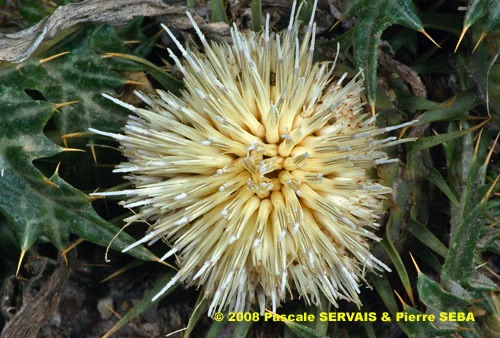
Cynara cornigera Lindl.
Fam. : Asteraceae
© Pascale SERVAIS & Pierre SEBA, 2018. Tilo Botanica: Flore de Tilos et du Dodécanèse / Flora of Tilos and of the Dodecanese
English translation by Brenda Bradbury, Howard Bradbury and Stéphane Léonard
Plante herbacée, hermaphrodite, basse, à tiges côtelées, plus courtes que les feuilles.
Feuilles à la base et alternes, divisées pennatipartites à pennatiséquées, oblongues, très découpées, veinées de blanc au-dessus, aplaties au sol en rosette, à épines solitaires.
Fleurs jaune blanchâtre, réunies en capitules de 50 mm de diamètre, solitaires ou peu nombreux, entourés de longues bractées épineuses. Ovaire infère.
Fruits, akènes à touffe de poils plumeux.
___________________________
Plant herbaceous, hermaphrodite, low. Stems ribbed, shorter than the leaves.
Leaves at the base and alternate, dissected pinnatipartite to pinnatisect, oblong, very indented, veined of white above, flattened in a rosette on the ground, with solitary thorns.
Flowers whitish yellow, joined together in capitula of 50 mm in diameter, solitary or very few, surrounded by long spiny bracts. Ovary inferior.
Fruits, achenes with a tuft of feathery hairs.
Descripteurs / Identifying features
1
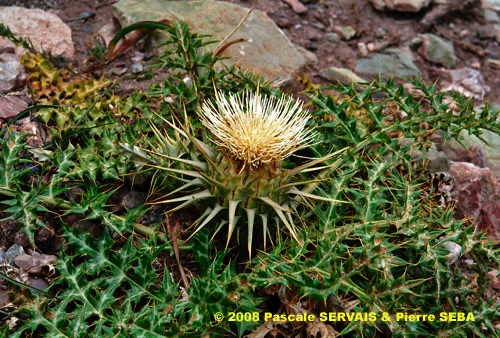
2
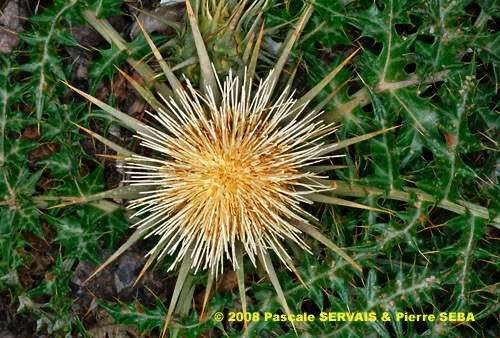
3
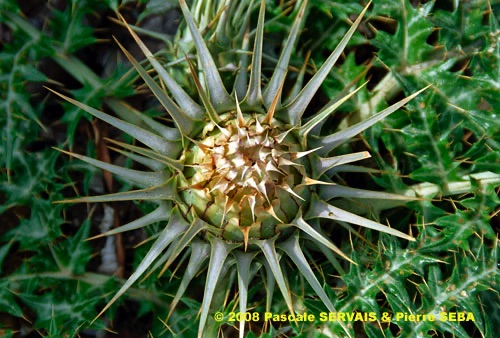
4
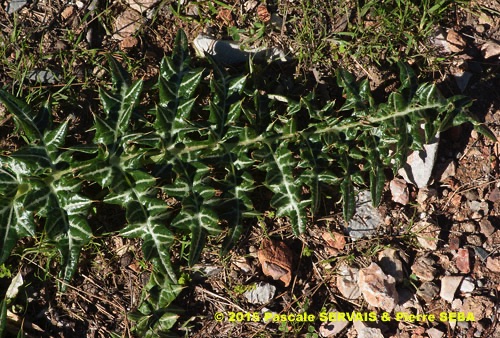
5
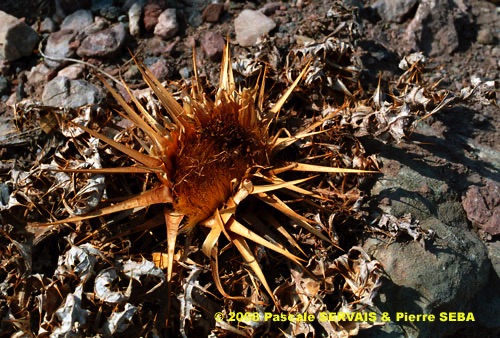
6
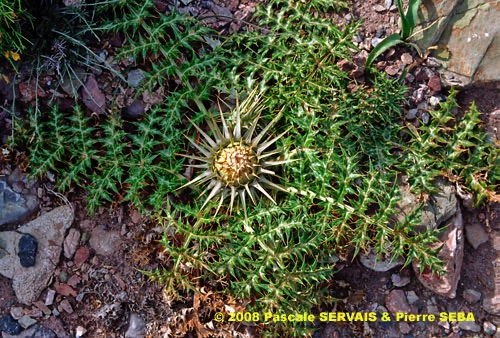
7
Étymologie / Etymology :
Cynara : emprunt du grec ancien κύων, κυνός (nom) = le chien,
en référence aux bractées de l’involucre qui ressemblent à des
dents de chien.
Cornigera : emprunt du latin corniger, -era, -erum (adj.)
[ < cornu, -us (nom) = la corne + gero, -is, -ere (verbe) = porter ]
= qui porte des cornes, cornu.
Cynara : borrowed from Classical Greek κύων, κυνός (noun) = dog,
referring to the bracts of involucre that look like dogs' teeth.
Cornigera : borrowed from Latin corniger, -era, -erum (adj)
[ < cornu, -us (noun) = horn, antler + gero, -is, -ere (verb) = to carry ]
= with a horn, horned.
Synonyme / Synonym :
Cynara sibthorpiana Boiss. & Heldr.
Noms vernaculaires / Common names :
Nom français / French name :
Chardon cornu.
Noms grecs / Greek names :
Αγκινάρα του βουνού — Αγριαγκινάρα.
Habitat :
Lieux pierreux - Sols sableux - Chemins.
Stony places - Sandy soils - Waysides.
Île / Island :
Tilos.
Hauteur / Height range :
De 10 cm à 30 cm.
From 10 cm to 30 cm.
Floraison / Flowering time :
D’avril à juin.
From April to June.
Groupe / Classification :
Dicotylédones.
Dicotyledons.
Pérennité / Lifespan :
Vivace.
Perennial.
Description :
Clés dichotomiques et descripteurs distinctifs des 2 espèces / Dichotomous keys and distinctive identifying features of the 2 species
Photo 1 :
Localisation / Location : Tilos, Livadia, Chemin de Lethra
Date : 22/04/2008
GPS : Lat. 36,42442° N / Long. 27,38924° E / Alt. 56 m
Type : Photographie numérique / Digital Photograph (10 mégapixels)
Photo 2 :
Localisation / Location : Tilos, Livadia, Chemin de Lethra
Date : 01/05/2006
GPS : Lat. 36,42442° N / Long. 27,38924° E / Alt. 56 m
Type : Kodak Gold 200 ASA
Photo 3 :
Localisation / Location : Tilos, Livadia, Chemin de Lethra
Date : 01/05/2006
GPS : Lat. 36,42442° N / Long. 27,38924° E / Alt. 56 m
Type : Kodak Gold 200 ASA
Photo 4 :
Localisation / Location : Tilos, Livadia, Chemin de Lethra
Date : 26/04/2006
GPS : Lat. 36,42442° N / Long. 27,38924° E / Alt. 56 m
Type : Kodak Gold 200 ASA
Photo 5 :
Localisation / Location : Tilos, Megalochorio, Chemin de Skafi
Date : 05/03/2015
GPS : Lat. 36,45933° N / Long. 27,34989° E / Alt. 70 m
Type : Photographie numérique / Digital Photograph (10 mégapixels)
Photo 6 :
Localisation / Location : Tilos, Livadia, Chemin de Lethra
Date : 11/10/2007
GPS : Lat. 36,42442° N / Long. 27,38924° E / Alt. 56 m
Type : Kodak Gold 200 ASA
Photo 7 :
Localisation / Location : Tilos, Livadia, Chemin de Lethra
Date : 26/04/2006
GPS : Lat. 36,42442° N / Long. 27,38924° E / Alt. 56 m
Type : Kodak Gold 200 ASA

Google Maps
Google Maps
Google Maps
Google Maps
Google Maps
Google Maps
Google Maps